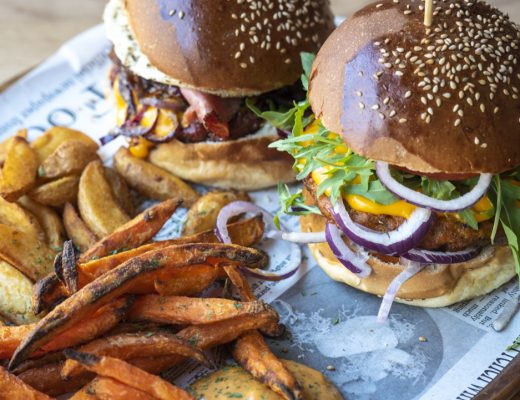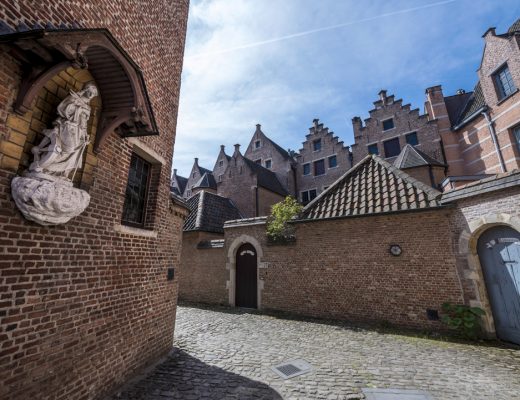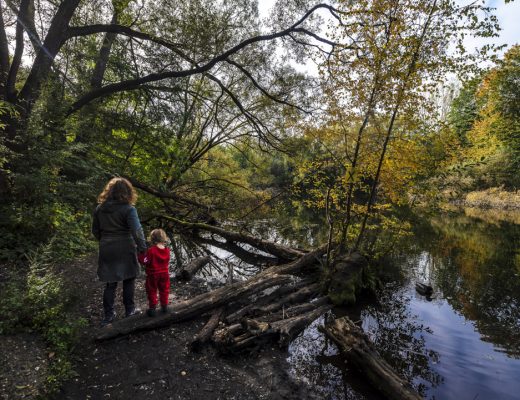In sunny Ticino, Switzerland suddenly takes on a Mediterranean flair. The country’s only Italian-speaking canton swaps alpine cottages for colourful piazzas, and on the shores of beautiful Lago Maggiore, you can enjoy the beach in the shade of a palm tree. Trot Op! took a thorough look around.

Booking a trip to Switzerland? In many people’s minds, this almost automatically means spending whole days swooshing down the slopes and dipping bread into a cheese fondue – just to fill you up for the après-ski. If you visit in summer, you’ll swap your skis for hiking boots and trek through green Alpine meadows full of cows driven mad by the bells around their necks. Both are wonderful holidays, but these typical images don’t always reflect reality. In the south of Switzerland, there’s one canton where things are done a bit differently. In Ticino, you can still enjoy the Alps, but you’ll feel like you’re in an entirely different country at first glance. On the shores of stunning Lago Maggiore, log cabins and pine forests are replaced by sunny boulevards, Venetian facades and palm trees. In terms of language, architecture, gastronomy and the frequent use of vigorous hand gestures, you feel like you’re in Italy, though it lies safely across the water. No worries though: in Switzerland’s only Italian-speaking canton, they love la bella vita just as much. Be it just a tad more orderly – they’re still Swiss, after all.
Ticino & Lago Maggiore: 5 amazing sights to enjoy in Italian Switzerland
Ticino is considered the gateway to the South by the Swiss, and they didn’t make it up – Milan is just an hour’s drive from Lugano. The South however, already begins in Switzerland itself. On the shores of Lago Maggiore, you can sunbathe on white sandy beaches, shop in designer boutiques or drink espresso on a colourful piazza. If you fancy a decent pasta, you don’t have to cross the border for one either – they make them just as tasty here.
“In Ticino, log cabins and pine forests are replaced by sunny boulevards, Venetian facades and palm trees. In terms of language, architecture, gastronomy and the frequent use of an array of vigorous hand gestures, you feel like you’re in Italy.”
Yet the mountains are never far away. Just a few kilometres from the Mediterranean towns lie valleys full of deep gorges, roaring waterfalls and centuries-old stone villages. If you book a trip in winter, you can go skiing on the slopes in the morning to then enjoy a glass of rosé on a sunny terrace by the water. It’s the combination of everything you expect from a Swiss mountain holiday with a sniff of Italian charm that makes Ticino a unique destination. We jumped on the TGV in Brussels and decided to take a closer look. The following five attractions stood out the most to us.
1. Ascona: a town of art and music



Ascona is a tiny but beautiful town, known as a popular holiday destination for many years. The promenade along the water, full of pastel-coloured facades, cafés and palm trees, is a sight to behold, but there’s more to see. The centre is a maze of cobblestone streets filled with boutiques and artisanal shops, where you can make a few interesting stops. The San Pietro e Paolo church for example, is covered in beautiful frescoes. The art and music scene is surprisingly diverse for a town of this size as well. In the early twentieth century, a group of pre-flower-power hippies gathered on the Monte Verità – the “Mountain of Truth” but in essence just a hill above the town – to establish a community based on principles like vegetarianism and (of course: must have boobies) nudism. This attracted many artists and intellectuals who subsequently kept hanging around (boobies). Today, you’ll only find a beautiful garden and a museum on Monte Verità, but the art and music have never left Ascona. Every year near the end of June, JazzAscona takes place on the shores of the lake. Many musicians perform for several days, and New Orleans-style brass bands parade through the streets. Unfortunately, I was invited a week or two too early to experience it myself – which was of course, quite inconvenient.
2. Locarno: film festivals on the Piazza Grande



*Left picture by the lovely Mirjam Hart of Een Goede Reis
Locarno lies right next to Ascona across the Maggia River and is similar in many ways, though slightly larger. It’s considered the sunniest destination in Switzerland and has a pleasant promenade along the water just like its neighbour. Two attractions stand out. Sacro Monte Madonna del Sasso is a pilgrimage site overlooking the town from a hill. You can reach it by a steep climb or by using the funicular from the town centre. The Piazza Grande is a beautiful square full of bars and restaurants where the Locarno Film Festival, one of the oldest in the world, has been held since 1946. The strangest place in Locarno in my opinion, is the Chiesa Nuova. This is a lovely church that wouldn’t be so remarkable if it didn’t have a unique relic on display. Instead of the usual finger bones, there’s a fully mummified saint displayed behind glass. Saint Germanus – I have no idea what miracles he performed – looks like a dried-up zombie in ancient armour, grinning his ghastly smile towards the churchgoers. Perfect for the kids.
3. Isole di Brissago: floating gardens in Lago Maggiore




While both Ascona and Locarno are lovely destinations for a pleasant holiday, the biggest attractions in the area are a bit further afield. Isole di Brissago for example, is an island – actually, there are two, but one is off-limits – in the middle of Lago Maggiore, accessible via a short boat trip from Ascona. Once you arrive, you can walk through a fantastic botanical garden with over 1,500 mainly subtropical plant species. This garden was established in the 19th century by Baroness Antoinette Saint-Léger. Many of the trees she planted here are still standing today. Unfortunately, Antoinette was better at planting trees than at investing wisely, because she went bankrupt and had to sell the entire property to German magnate Max Emden. He built a huge villa on the island – which the baroness could still see from her new poor people apartment on the lake shore – to host various Hugh Hefner-style sex parties in. After his death, the party was over and the gardens came into the possession of the canton, growing into a popular tourist attraction. This is entirely deserved. Although it can be quite busy, you can always find beautiful, peaceful spots and even swimming areas to enjoy. It’s an ideal place for an afternoon outing and is open from March to November.
4. Val Bavona: a spectacular rock valley




A half-hour drive from Locarno lies Val Bavona. This is one of the rockiest and most inhospitable valleys in the Swiss Alps. This makes for fantastic views but also for an extremely harsh life for those brave enough to live in it. Less than two percent of the area is suitable for agriculture, so shepards in the past had to drive their flocks higher up into the mountains to find enough grass. Today, the valley is no longer permanently inhabited. The villages you encounter consist of renovated summer houses owned by people who live by the lake the rest of the year – there’s no electricity. In winter, no one lives here because the snow makes the valley inaccessible. Yet these villages are of historical importance, mainly due to the numerous Splüi they’ve constructed throughout the ages. Spluï are homes and storage places built or dug under overhanging cliffs or fallen rocks. You can find more than 1,500 of these structures here; the Splüia Bèla probably being the most spectacular. In summer, Val Bavona is a fantastic place to explore, offering many photogenic views. Foroglio for example, looks like a fairy-tale village and is located at the foot of a more than 100-meter-high waterfall crashing down the rocks. A swing was installed in the pool below it – Instagrammers know where to go. Other beautiful town are Sonlerto, Rodeto and Sabbione. The latter almost looks like a hobbit village. Thanks to Swiss efficiency, you can get to all of them by bus. According to Swiss law, every even slightly inhabited hamlet in Switzerland must be accessible by public transport. How long you’ll have to wait for another bus is of course a different story.
5. Taste Swiss wine in Terreni alla Maggia



Given that Italy is literally across the lake, you would expect to find some good wine in Ticino as well. And praise the lord: this is the case. Terreni alla Maggia in Ascona is the ideal place to have a taste. It’s a 150-hectare estate where besides wine, many other crops are grown. The northernmost rice in Europe is cultivated here, mainly used for risotto. The twelve hectares of vineyards grow a wide variety of grapes. This results in a diverse range of white, red, and rosé wines. You can taste them all here, accompanied by some local snacks. The Merlot they produce ages for three years in French oak barrels. Afterwards, these barrels are used to store single malt. Yes, they produce Swiss whisky and gin as well. Both are quite enjoyable and are sold in bottles that would look very nice on your booze shelf at home.
Extra information and hotels in Ticino

For more information about Switzerland as a tourist destination, click here.
For everything you need to know about Ticino, click here.
We stayed at Hotel Belvedere Locarno. This is a large, classic hotel with a great restaurant and spacious rooms with balconies overlooking Locarno and Lago Maggiore.
Every visitor staying overnight in hotels, youth hostels or campsites in Ticino receives a “Ticino Ticket”. This allows you to use all public transport for free and gives you discounts on many activities. You get the ticket upon arrival, and it’s valid until the end of the day you depart. For more info, click here.
I’d like to mention Daphne and her blog Road to Wander, who together with Mirjam was a very enthusiastic model for my waterfall pics.
If you want to go to Switzerland in winter but can’t ski, get inspired by my article about Interlaken. For some other European trips, read my pieces about Duisburg, Noordwijk, Friesland, Prague, The Vaucluse, Scotland, and Amsterdam-Noord.
(Lago Maggiore picture below also by Mirjam Hart)

































No Comments